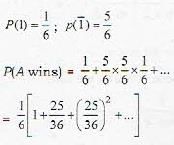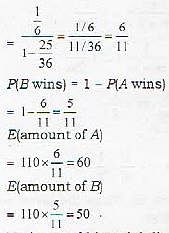Mathematics Exam > Mathematics Questions > A and B throw a die in succession to win a be...
Start Learning for Free
A and B throw a die in succession to win a bet with A starting first. Whoever throws '1' first wins an amount of Rs. 110. What are the respective expectations of A and B?
- a)Rs. 70 and Rs. 40
- b)Rs. 60 and Rs. 50
- c)Rs. 75 and Rs. 35
- d)none of these
Correct answer is option 'B'. Can you explain this answer?
| FREE This question is part of | Download PDF Attempt this Test |
Verified Answer
A and B throw a die in succession to win a bet with A starting first. ...


Most Upvoted Answer
A and B throw a die in succession to win a bet with A starting first. ...
Expectation is a measure of the average value or outcome of a random variable. In this case, we want to find the respective expectations of A and B in the game they are playing.
Let's analyze the game step by step to determine the expectations of A and B.
- A starts by throwing the die. The probability of getting a 1 is 1/6, and the probability of not getting a 1 is 5/6.
- If A does not get a 1, it is now B's turn to throw the die. Similarly, the probability of B getting a 1 is 1/6, and the probability of not getting a 1 is 5/6.
Now, let's calculate the respective expectations of A and B.
- A's Turn:
- If A gets a 1 on the first throw, A wins Rs. 110.
- If A does not get a 1 on the first throw, the game continues to B's turn.
- The expected value of A's turn can be calculated as follows:
- E(A) = (1/6) * 110 + (5/6) * E(B)
- The first term represents the probability of A winning Rs. 110 on the first throw.
- The second term represents the probability of not winning on the first throw, and the game continues to B's turn.
- B's Turn:
- If B gets a 1 on the first throw, B wins Rs. 110.
- If B does not get a 1 on the first throw, the game continues to A's turn.
- The expected value of B's turn can be calculated as follows:
- E(B) = (1/6) * 110 + (5/6) * E(A)
- The first term represents the probability of B winning Rs. 110 on the first throw.
- The second term represents the probability of not winning on the first throw, and the game continues to A's turn.
Now, we can substitute the value of E(B) into the equation for E(A) and solve the system of equations to find the respective expectations of A and B.
By solving the equations, we find that E(A) = Rs. 60 and E(B) = Rs. 50.
Therefore, the respective expectations of A and B are Rs. 60 and Rs. 50, which matches option B.
Let's analyze the game step by step to determine the expectations of A and B.
- A starts by throwing the die. The probability of getting a 1 is 1/6, and the probability of not getting a 1 is 5/6.
- If A does not get a 1, it is now B's turn to throw the die. Similarly, the probability of B getting a 1 is 1/6, and the probability of not getting a 1 is 5/6.
Now, let's calculate the respective expectations of A and B.
- A's Turn:
- If A gets a 1 on the first throw, A wins Rs. 110.
- If A does not get a 1 on the first throw, the game continues to B's turn.
- The expected value of A's turn can be calculated as follows:
- E(A) = (1/6) * 110 + (5/6) * E(B)
- The first term represents the probability of A winning Rs. 110 on the first throw.
- The second term represents the probability of not winning on the first throw, and the game continues to B's turn.
- B's Turn:
- If B gets a 1 on the first throw, B wins Rs. 110.
- If B does not get a 1 on the first throw, the game continues to A's turn.
- The expected value of B's turn can be calculated as follows:
- E(B) = (1/6) * 110 + (5/6) * E(A)
- The first term represents the probability of B winning Rs. 110 on the first throw.
- The second term represents the probability of not winning on the first throw, and the game continues to A's turn.
Now, we can substitute the value of E(B) into the equation for E(A) and solve the system of equations to find the respective expectations of A and B.
By solving the equations, we find that E(A) = Rs. 60 and E(B) = Rs. 50.
Therefore, the respective expectations of A and B are Rs. 60 and Rs. 50, which matches option B.
Free Test
FREE
| Start Free Test |
Community Answer
A and B throw a die in succession to win a bet with A starting first. ...



|
Explore Courses for Mathematics exam
|

|
Similar Mathematics Doubts
A and B throw a die in succession to win a bet with A starting first. Whoever throws '1' first wins an amount of Rs. 110. What are the respective expectations of A and B?a)Rs. 70 and Rs. 40b)Rs. 60 and Rs. 50c)Rs. 75 and Rs. 35d)noneof theseCorrect answer is option 'B'. Can you explain this answer?
Question Description
A and B throw a die in succession to win a bet with A starting first. Whoever throws '1' first wins an amount of Rs. 110. What are the respective expectations of A and B?a)Rs. 70 and Rs. 40b)Rs. 60 and Rs. 50c)Rs. 75 and Rs. 35d)noneof theseCorrect answer is option 'B'. Can you explain this answer? for Mathematics 2024 is part of Mathematics preparation. The Question and answers have been prepared according to the Mathematics exam syllabus. Information about A and B throw a die in succession to win a bet with A starting first. Whoever throws '1' first wins an amount of Rs. 110. What are the respective expectations of A and B?a)Rs. 70 and Rs. 40b)Rs. 60 and Rs. 50c)Rs. 75 and Rs. 35d)noneof theseCorrect answer is option 'B'. Can you explain this answer? covers all topics & solutions for Mathematics 2024 Exam. Find important definitions, questions, meanings, examples, exercises and tests below for A and B throw a die in succession to win a bet with A starting first. Whoever throws '1' first wins an amount of Rs. 110. What are the respective expectations of A and B?a)Rs. 70 and Rs. 40b)Rs. 60 and Rs. 50c)Rs. 75 and Rs. 35d)noneof theseCorrect answer is option 'B'. Can you explain this answer?.
A and B throw a die in succession to win a bet with A starting first. Whoever throws '1' first wins an amount of Rs. 110. What are the respective expectations of A and B?a)Rs. 70 and Rs. 40b)Rs. 60 and Rs. 50c)Rs. 75 and Rs. 35d)noneof theseCorrect answer is option 'B'. Can you explain this answer? for Mathematics 2024 is part of Mathematics preparation. The Question and answers have been prepared according to the Mathematics exam syllabus. Information about A and B throw a die in succession to win a bet with A starting first. Whoever throws '1' first wins an amount of Rs. 110. What are the respective expectations of A and B?a)Rs. 70 and Rs. 40b)Rs. 60 and Rs. 50c)Rs. 75 and Rs. 35d)noneof theseCorrect answer is option 'B'. Can you explain this answer? covers all topics & solutions for Mathematics 2024 Exam. Find important definitions, questions, meanings, examples, exercises and tests below for A and B throw a die in succession to win a bet with A starting first. Whoever throws '1' first wins an amount of Rs. 110. What are the respective expectations of A and B?a)Rs. 70 and Rs. 40b)Rs. 60 and Rs. 50c)Rs. 75 and Rs. 35d)noneof theseCorrect answer is option 'B'. Can you explain this answer?.
Solutions for A and B throw a die in succession to win a bet with A starting first. Whoever throws '1' first wins an amount of Rs. 110. What are the respective expectations of A and B?a)Rs. 70 and Rs. 40b)Rs. 60 and Rs. 50c)Rs. 75 and Rs. 35d)noneof theseCorrect answer is option 'B'. Can you explain this answer? in English & in Hindi are available as part of our courses for Mathematics.
Download more important topics, notes, lectures and mock test series for Mathematics Exam by signing up for free.
Here you can find the meaning of A and B throw a die in succession to win a bet with A starting first. Whoever throws '1' first wins an amount of Rs. 110. What are the respective expectations of A and B?a)Rs. 70 and Rs. 40b)Rs. 60 and Rs. 50c)Rs. 75 and Rs. 35d)noneof theseCorrect answer is option 'B'. Can you explain this answer? defined & explained in the simplest way possible. Besides giving the explanation of
A and B throw a die in succession to win a bet with A starting first. Whoever throws '1' first wins an amount of Rs. 110. What are the respective expectations of A and B?a)Rs. 70 and Rs. 40b)Rs. 60 and Rs. 50c)Rs. 75 and Rs. 35d)noneof theseCorrect answer is option 'B'. Can you explain this answer?, a detailed solution for A and B throw a die in succession to win a bet with A starting first. Whoever throws '1' first wins an amount of Rs. 110. What are the respective expectations of A and B?a)Rs. 70 and Rs. 40b)Rs. 60 and Rs. 50c)Rs. 75 and Rs. 35d)noneof theseCorrect answer is option 'B'. Can you explain this answer? has been provided alongside types of A and B throw a die in succession to win a bet with A starting first. Whoever throws '1' first wins an amount of Rs. 110. What are the respective expectations of A and B?a)Rs. 70 and Rs. 40b)Rs. 60 and Rs. 50c)Rs. 75 and Rs. 35d)noneof theseCorrect answer is option 'B'. Can you explain this answer? theory, EduRev gives you an
ample number of questions to practice A and B throw a die in succession to win a bet with A starting first. Whoever throws '1' first wins an amount of Rs. 110. What are the respective expectations of A and B?a)Rs. 70 and Rs. 40b)Rs. 60 and Rs. 50c)Rs. 75 and Rs. 35d)noneof theseCorrect answer is option 'B'. Can you explain this answer? tests, examples and also practice Mathematics tests.

|
Explore Courses for Mathematics exam
|

|
Suggested Free Tests
Signup for Free!
Signup to see your scores go up within 7 days! Learn & Practice with 1000+ FREE Notes, Videos & Tests.


















